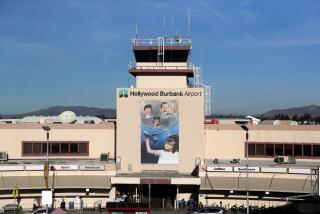Aviation Officials Urge More Runways
- Share via
WASHINGTON — Aviation industry leaders and lawmakers urged construction of additional runways to increase capacity at the nation’s airports Thursday, sounding a call for aggressive airport development that may resonate with supporters of a plan to expand Los Angeles International Airport.
Industry and government officials brainstormed ways to address the “capacity crisis” at a summit organized by the air traffic controllers’ union and an alliance of domestic air carriers. Airports nationwide are struggling to address the problem as passenger traffic surges, resulting in a rise in flight delays and safety concerns.
Officials stressed that the growth in air passenger traffic has drastically outpaced the rate of new runway construction.
Charles Barclay, president of the American Assn. of Airport Executives, said that during the last decade, while passenger traffic in America increased by 40%, only six new runways were built at major airports. The runway shortage highlights a dangerous “lack of capacity at key choke points in the system,” he said.
A number of officials at the summit said that the opposition of local communities often proves a major roadblock to much-needed airport expansions, as nearby residents too often adopt a “not in my backyard” attitude to expansion proposals because of concerns about increased air pollution, noise and traffic.
It can take as long as 10 years to get a new runway approved because of the lengthy process of obtaining federal and state environmental permits. Critics of airport expansion have expressed concern that environmental and safety issues could be compromised if the runway construction process is shortened.
James Coyne, president of the National Air Transportation Assn., said local politicians naturally fall in line with their constituents’ opposition to airport expansion.
“It’s not rocket science for the local politician,” Coyne said. “He’s going to come up against the airport again and again.”
But Rep. James L. Oberstar (D-Minn.) said local authorities cannot have it both ways. “If [cities and counties] want the economic benefits of aviation . . . then they’ve got to take ownership of them.”
Barclay said that, in many cities, while “a majority [of residents] have already decided they want to increase capacity” at their airport, “a vocal, litigious minority is fighting.”
The government, including the Federal Aviation Administration, should take a more active role in capacity-building moves, Barclay said.
“[By] sitting back and watching, the government is arming the opposition with tools of delay,” he said.
In fact, federal authorities agreed last week to intervene in the ongoing debate over LAX’s controversial $12-billion expansion proposal. Although proposals to build one or two new runways at LAX were dropped from the plan, several components geared toward boosting capacity, such as a lengthened runway and a new terminal and gates, remain in the proposal.
Transportation Secretary Norman Y. Mineta is forming a federal task force to examine the possibility of using Southern California’s numerous regional airports instead of an expansion of LAX to absorb a projected doubling of air passengers in the area by 2025. Mineta’s action came during a meeting with a group of local elected officials united in strong opposition to the LAX master plan.
The remarks by officials at Thursday’s summit appear to contradict the arguments of regional expansion proponents that LAX should not be expanded. Aviation officials cited passenger safety and flight delays as among their greatest concerns in the airport capacity crunch.
Indeed, recent FAA and Department of Transportation statistics have shown that, among the nation’s busiest airports, LAX has both the highest rate of near-collisions on runways and the third-worst record on late arrivals.
Still, Barclay said officials’ focus should be on working to enhance the quality of the nationwide air transportation network rather than on choosing sides in local airport expansion debates.
“It’s not about picking one alternative over another,” Barclay said. “It’s [about] saying that there are national interests at stake and that they should be represented.”
At the end of Thursday’s conference, the industry groups signed a letter asking President Bush to make runway construction a national priority. “The aviation system will slide into gridlock in the next decade if measures to increase and speed capacity improvements do not receive immediate attention and support,” the letter said.
A White House spokeswoman reiterated Bush’s support for new runways, calling it “a priority of the administration.”
More to Read
Sign up for Essential California
The most important California stories and recommendations in your inbox every morning.
You may occasionally receive promotional content from the Los Angeles Times.













